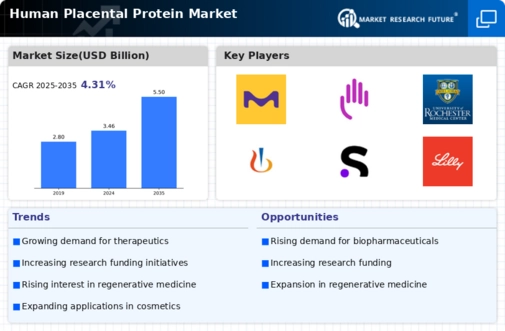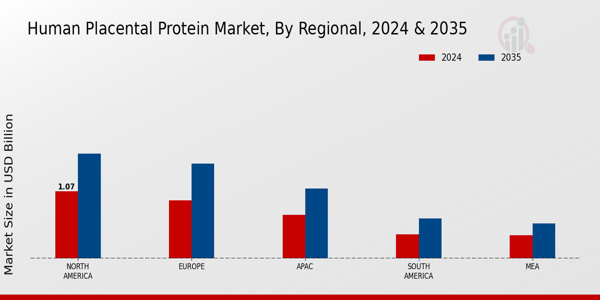Market Growth Projections
The Global Human Placental Protein Market Industry is projected to experience substantial growth in the coming years. By 2024, the market is expected to reach a valuation of 3.46 USD Billion, with further growth anticipated as the industry evolves. Projections indicate that by 2035, the market could reach 5.5 USD Billion, reflecting a robust CAGR of 4.3% from 2025 to 2035. This upward trajectory suggests a growing recognition of the therapeutic potential of placental proteins across various medical applications, reinforcing their role in future healthcare solutions.
Advancements in Medical Research
Advancements in medical research play a crucial role in shaping the Global Human Placental Protein Market Industry. Innovative studies are continuously revealing the multifaceted roles of placental proteins in human health, including their involvement in cell signaling and immune modulation. These insights are fostering the development of novel therapeutic agents. As a result, the market is anticipated to grow at a CAGR of 4.3% from 2025 to 2035, potentially reaching 5.5 USD Billion by 2035. This growth trajectory underscores the importance of ongoing research initiatives and collaborations between academic institutions and industry stakeholders.
Rising Demand for Biopharmaceuticals
The Global Human Placental Protein Market Industry is experiencing a notable increase in demand for biopharmaceuticals. This trend is largely driven by the growing recognition of the therapeutic potential of placental proteins in treating various diseases. For instance, placental proteins have shown promise in regenerative medicine and immunotherapy. As the industry evolves, the market is projected to reach 3.46 USD Billion in 2024, with expectations of further growth as research continues to unveil new applications. The increasing investment in biopharmaceutical research is likely to bolster the market, indicating a robust trajectory for placental protein utilization.
Increasing Awareness of Maternal Health
The Global Human Placental Protein Market Industry is significantly influenced by the increasing awareness of maternal health. As healthcare providers and patients alike recognize the importance of placental health, there is a growing interest in the therapeutic applications of placental proteins. This awareness is driving demand for products that utilize these proteins in prenatal care and maternal health solutions. The market's expansion is indicative of a broader trend towards personalized medicine, where placental proteins are tailored to meet individual health needs. This shift is expected to contribute to the market's growth, enhancing its relevance in maternal healthcare.
Regulatory Support for Biotech Innovations
Regulatory support for biotechnology innovations is a pivotal driver of the Global Human Placental Protein Market Industry. Governments and regulatory bodies are increasingly recognizing the potential of placental proteins in therapeutic applications, leading to streamlined approval processes for related products. This supportive regulatory environment encourages investment and research in placental protein applications, facilitating market entry for new therapies. As a result, the industry is poised for growth, with projections indicating a market value of 3.46 USD Billion in 2024. Such regulatory frameworks are essential for fostering innovation and ensuring the safe use of placental proteins in medical applications.
Emerging Applications in Regenerative Medicine
Emerging applications of placental proteins in regenerative medicine are reshaping the Global Human Placental Protein Market Industry. The unique properties of these proteins, such as their ability to promote cell growth and tissue repair, are garnering attention in the field of regenerative therapies. As researchers explore these applications, the market is expected to expand significantly, with a projected CAGR of 4.3% from 2025 to 2035. This growth is indicative of the increasing integration of placental proteins into therapeutic strategies aimed at treating degenerative diseases and injuries, highlighting their potential in advancing medical science.























